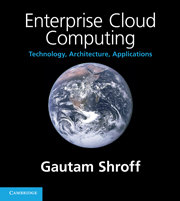Book contents
- Frontmatter
- Contents
- Preface
- List of abbreviations
- Part I Computing platforms
- Part II Cloud platforms
- Chapter 5 Cloud computing platforms
- Chapter 6 Cloud computing economics
- Part III Cloud technologies
- Part IV Cloud development
- Part V Software architecture
- Part VI Enterprise cloud computing
- References
- Index
Chapter 5 - Cloud computing platforms
Published online by Cambridge University Press: 06 December 2010
- Frontmatter
- Contents
- Preface
- List of abbreviations
- Part I Computing platforms
- Part II Cloud platforms
- Chapter 5 Cloud computing platforms
- Chapter 6 Cloud computing economics
- Part III Cloud technologies
- Part IV Cloud development
- Part V Software architecture
- Part VI Enterprise cloud computing
- References
- Index
Summary
In this chapter we shall describe the major public cloud platforms from Amazon, Google and Microsoft, outlining the services they provide from an end-user's perspective. (While there are other providers who have similar offerings, as of this writing they are smaller. In Chapter 17 we also describe other cloud providers as well as the larger cloud computing ecosystem including cloud management applications and tools for building private clouds.)
INFRASTRUCTURE AS A SERVICE: AMAZON EC2
The Amazon cloud provides infrastructure as a service (IaaS), whereby computing infrastructure such as for servers, storage or network end points of a desired capacity are virtually provisioned in minutes through an automated web-based management console. This core IaaS service, called Elastic Compute Cloud, or EC2, is but one of a set of services that constitute the Amazon cloud platform, but the term EC2 is also often used to describe the entire cloud offering.
Figure 5.1 illustrates the services provided by the Amazon infrastructure cloud from a user perspective. These services are implemented on a very large network of servers, shown as dashed boxes in the figure. The Elastic Compute Cloud service provides users access to dedicated virtual machines of a desired capacity that are provisioned on these physical servers, with details of the actual physical server, such as its location, capacity, etc. being transparent to the end-user.
Information
- Type
- Chapter
- Information
- Enterprise Cloud ComputingTechnology, Architecture, Applications, pp. 51 - 63Publisher: Cambridge University PressPrint publication year: 2010
